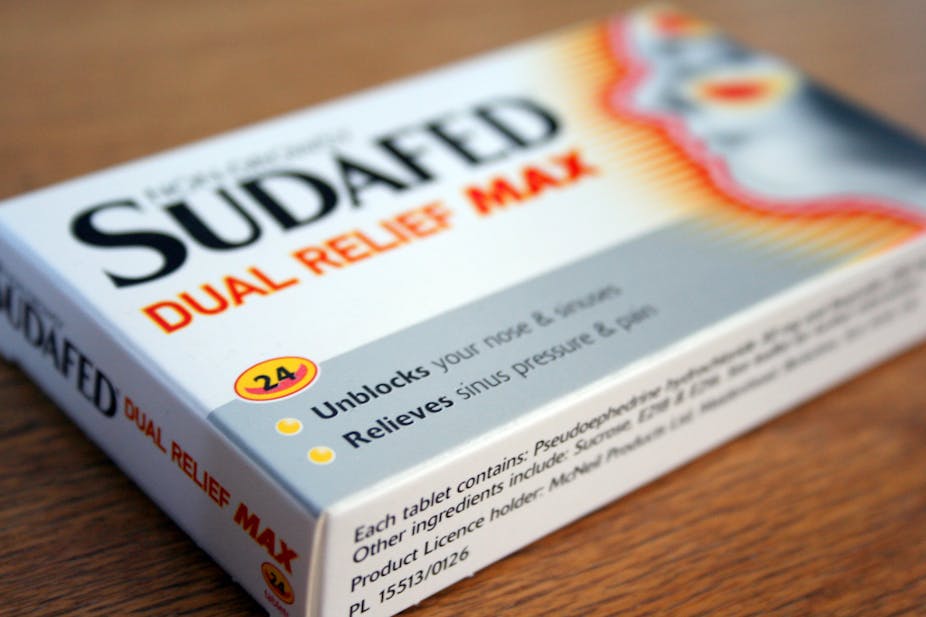The process of buying over-the-counter cold-and-flu medicines, and the types of products available, has changed in recent years. Some pharmacies no longer stock pseudoephedrine-based products, and in others, you may be asked to show identification, such as a driver’s licence, beforehand.
Such ID information is entered into a real-time, web-based database that records your address, name and driver’s licence number. The database is called Project STOP and it’s an initiative of the Queensland branch of the Pharmacy Guild of Australia and the Queensland Police Service.
The partnership resulted from concerns about the raft of problems associated with significant increases in the use and abuse of psycho-stimulant drugs, commonly known as amphetamine-type substances (or stimulants). It was thought that increases in drug overdoses, hospital admissions, illegal laboratory seizures, and related crime problems (such as armed robberies and ram-raids on pharmacies) stemmed from pseudoephedrine being used to make illicit stimulants, such as methamphetamine and ecstasy.
Pseudoephedrine is found in a number of cold-and-flu tablets, and is known to be an “illicit drug precursor” because it can be diverted into the manufacture of amphetamine-type substances. These substances stimulate the central nervous system by increasing synaptic concentrations of three major neurotransmitters in the brain – dopamine, serotonin (5-HT) and noradrenaline. Problems for users can include anxiety, panic attacks, paranoia and depression. And there are flow-on harms to the community through crime and violence.
Project STOP is now rolled out nationally, supported by funding from the federal government. It provides a convenient tool for pharmacists to comply with regulatory requirements and is mandated in some states. It can also give police real-time intelligence about drug problems and hotspots.
But despite the national roll-out, Project STOP is used differently across the states and territories.
A team of researchers, including myself, recently completed a research project about the initiative, exploring the different regulatory models adopted in Queensland and Victoria. We found the restrictions on the availability of methamphetamine precursors work best when state-based legislation and regulations support partnerships between police and community pharmacists.
Mandatory recording of identification details helps police keep track of potential “pseudo-runners” – people who shop for cold-and-flu tablets at many different pharmacies for illicit purposes. And it’s helpful when pharmacists are required to pass on information about pseudoephedrine sales within specified times to both police and the regulatory body responsible for pharmacists.
But this only occurs in Queensland, not Victoria. The Project STOP database also helps pharmacists to decide whether to proceed with suspicious pseudoephedrine sales.
Some pharmacists choose to opt out of the initiative by not stocking the products at all. But for others, the inconvenience of regulated sales is preferable to either not being able to provide the best medicine to their customers, or to the products being available only on prescription (as is now the case in New Zealand).
Project STOP helps translate individual sales data into useful police intelligence for the identification of trends, hotspots and patterns of activity in illicit or diverted pseudoephedrine products. The intelligence provided by the system can be incorporated into operational decision-making by police, and help them effectively plan and launch covert interventions.
Overall, the initiative seems to reduce the supply of pseudoephedrine to the illicit marketplace.
But we need greater consistency between state and federal governments’ approach to controlling methamphetamine precursors. Different reporting requirements create opportunities for cross-border purchases of pseudoephedrine products, place undue costs on franchise pharmacies (that must meet different rules according to location), and limit police capacity to examine national and regional patterns of illicit sales
Unfortunately, transferring good practice between states is currently inhibited by the different legislation that exists in each. These differences need to be analysed before we can assess whether a practice that succeeds in one state, such as Queensland, will be successful in others. Standardising state legislation will make the rolling out of good practice immeasurably easier, and ultimately help reduce the problems associated with illicit stimulant use in Australia.
This is the final article in our short series about pharmacies. Click on the link below to read the other instalments:
Part One: Pharmacy gravy train drives up the cost of prescription drugs
Part Two: Online pharmaceuticals: bricks, not clicks, keep us safe
Part Three: Note to pharmacists on how not to sell the morning-after pill
Part Four: Pharmacists should drop products that aren’t backed by evidence

